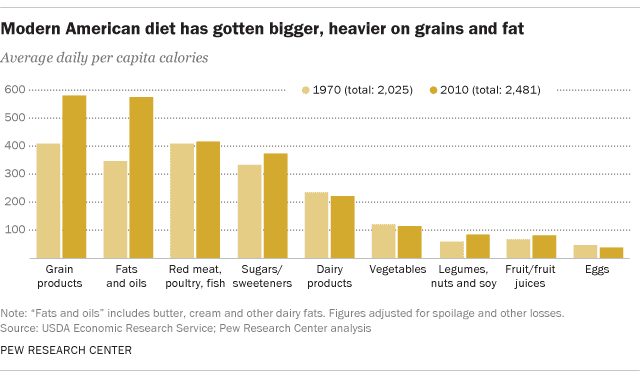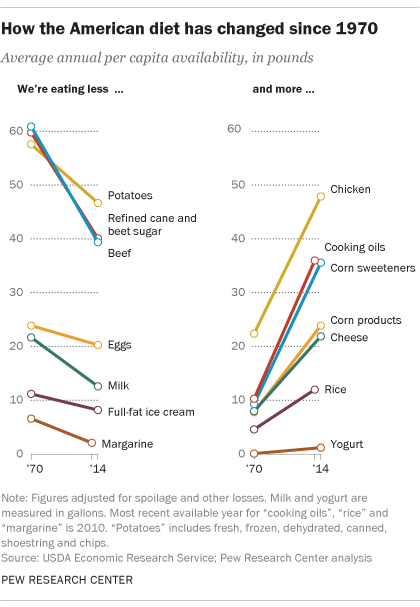
Take a Look at the Seismic Shifts in the American Diet Since 1970
For starters, we eat a lot more than we used to—including a 17-fold increase in yogurt consumption

The "fat American" stereotype isn't very nice, but does it have any truth to it? Turns out we're still in the top 20 heaviest nations on Earth, with 33% of our population considered to be obese. And while there are a number of contributing factors to that statistic, our diet may offer the most digestible explanation. According to a new study conducted by the Pew Research Center, "the average American consumed 2,481 calories a day in 2010, about 23% more than in 1970." It's a staggering change, especially since the average 40-year-old man who is "moderately active" only needs 2,400 calories to maintain his weight.
And of course, it’s not just how much we’re eating, it’s what we’re eating. Remember the pyramid of food groups? Suffice to say we’re not adhering to it very well. Nearly half of our overall diet now comes from just two groups—grains and flours in the forms of breads, pastries, and baked goods; and fats and oils—while our combined consumption of meats, dairies, fruits, and vegetables has fallen.

When it comes to fat, we are consuming less margarine, about the same amount of butter, but far more cooking oils. The study notes that data on fats and oils is incomplete due to flawed reporting, but that the spikes in fats and oils is mostly due to unsaturated varieties, as opposed to shortening and margarine. In terms of dairy, we drink 42% less milk than we did in 1970, but we’re eating almost three times as much cheese. And yogurt has seen a whopping 1,700% increase since then.
In the meat department, chicken has replaced beef as the reigning protein by a wide margin: chicken consumption has more than doubled while beef consumption has been falling steadily for decades, decreasing by roughly a third since 1970. Still, according to the Center for Science in the Public Interest, the combined consumptions of all red meats (beef, pork, lamb, veal) still outranks that of chicken.
It's clear there's no way to easily pinpoint whether we're eating "healthier" or not. But one discrepancy is that the general attitudes towards healthy eating, which are mostly positive, don't align with most people's perception of whether or not they are actually eating healthy foods. In a separate Pew survey on food and nutrition attitudes, 54% of those polled felt that Americans did pay more attention to eating healthy food compared to 20 years ago, yet, this is the same percentage of respondents who felt that Americans' "actual eating habits" were less healthy. It's also worth noting that many Americans, especially those with high scientific knowledge, are not very concerned with multiple, conflicting studies about healthy eating, believing that the "core ideals of healty eating are pretty well understood."
The Pew study doesn't address alcohol consumption, but the most recent Gallup poll suggests the number of drinkers hasn't changed significantly, and drinking patterns haven't fluctuated much, putting the focus back on the food we're eating. It also doesn't take into account exercise, in other words, whether or not the increased caloric intake is being mitigated by an increase in physical activity. So while there's no damning evidence on how our foods are making us fat, it's still helpful to visualize the data and think about how we can make small adjustments in our meals that will help tip the scales. Need some inspiration? Here are eight dishes that make healthy eating just a bit easier.
Keep Reading
Continue to Next Story










